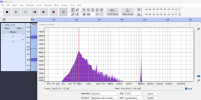- Joined
- Oct 25, 2024
- Messages
- 173
- Likes
- 50
Please use REW, Audacity often fail to present frequency responses correctly
Please measure the sample, using the REV program for both channels, where you can see, in numbers:
1. What is the highest amplitude of the test signal.
2. What is the highest amplitude of the unwanted resonance in the range of 0 to 20 Hz, and at what frequency did the peak of the amplitude of the unwanted resonance occur.
Sample test:
1kHz_2.wav
 drive.google.com
drive.google.com

